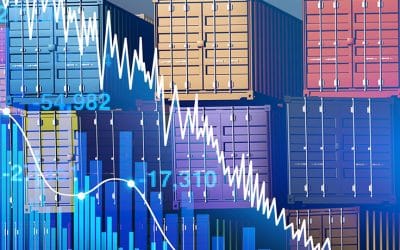Questions abound as we enter a new cycle

Redacción Mapfre
Gonzalo de Cadenas, director of macroeconomic and financial analysis at MAPFRE Economics.
After the successive shocks of the pandemic and the crisis in Ukraine, the global economy seems to be on the brink of a change of cycle. The inflationary supply pressures in Europe are now dragging growth down rather than pushing up prices. Core and underlying inflation, although far from where they should be, are clearly slowing down.
The US is still carrying inertia from the past (salaries and rental prices), although this will very gradually end up yielding to the lagging effects of monetary policy. European activity as a whole is stagnating, although with visible regional differences between the periphery and the center. The type of “landing” we can expect in 2024 is increasingly unknown.
A change in monetary policy is needed on both sides of the Atlantic, with the ECB cautious about growth and the Fed still determined to ratify its commitment to price stability. As a result, we’re now seeing increasing spreads that are adding to latent sovereign stress and, with this, a dollar that is naturally becoming stronger, reinforced by its nature as a safe haven.
With this in mind, during the transition between the previous inflationary stage and the cyclical landing still to come, we find ourselves with a monetary policy that, although uneven, now demonstrates tightening financial conditions on activity and potentially on financial stability. Mature economies are increasingly focusing their attention on two metrics: real rates and the volatility of nominal variables. This pairing might not only make it difficult to land in the cycle and impact the transition to the next, but it could also turn a potential liquidity crisis into a solvency crisis.
In this context, a new geopolitical conflict (in addition to the fifty already in progress) has opened up an additional path. Should the conflict triggered by Hamas reach regional dimensions, the economic consequences could repeat what we saw in the 1970s and 1980s, both in terms of price shock, risk aversion, and financial volatility. As was the case back then, this would happen in a monetary and fiscal context with no leeway. The result of this crisis and the “cost push” is well known. In fact, the increasingly significant role of geopolitics was already visible at the first Economic Observatory debate organized by MAPFRE Economics and El Confidencial.
So what’s the path ahead in terms of activity, prices, and financial volatility? Is there leeway in economic policy to deal with these issues? To what degree is the situation similar to what we’ve seen before?
There are different instruments that can be used in economic policy depending on the situation at hand. In terms of secular trends, the European and Spanish economies in particular have needed to make profound structural reforms (supply policies) in their factor markets and pension systems, something that I think we can agree has a bigger impact today, which is why it has stopped being implemented in favor of what has been done. Against a backdrop of cyclical weakness like the one we're currently witnessing, this is obvious.
This is also happening on a global playing field where regions are rushing to correct dependencies, position themselves strategically, and redefine global economic and political relations. We’re also witnessing the reconstruction of an industrial policy very similar to that of previous stages of transformation, which aims to confront what seems to be our most plausible future: a more fragmented and multipolar world.
And finally, hand in hand with the cycle and its changes, there’s the range of traditional demand policies. Following the fiscal and monetary expansion needed to overcome the crises that have been on everyone’s radar (Covid and Ukraine), we hesitated when it came to persistent inflation until we were convinced of the need to act by tightening monetary policy.
This is despite not being certain about the current functional relationship between activity and inflation, with doubts surrounding the position of the natural interest rate and with little information about the lag in the effect of monetary policy. Even so, we took rates to their highest in the past 15 years (although in real terms in Europe they are neutral). The usefulness of this decision will be visible when we determine whether the optimal strategy was to maintain high rates for a prolonged period of time, raise them additionally and -potentially- over-brake, or quickly undo what has been done as a result of a new global shock such as the one we could see in the near future.
Monetary policy always goes hand in hand with fiscal policy. In net terms, fiscal policy in Europe is neutral while in the US it remains expansive. The absence of additional fiscal space (debt), the risk of fiscal dominance and subtracting the effect of monetary policy, as well as the caution generated by the looming risk of fragmentation, make fiscal sustainability recommendable.
This raises the second series of question as we enter a new cycle: What space do we have for economic policy? How much of the current demand policy will have an effect and how much of it will be limited by the absence of past supply policies? Are we witnessing the reconstruction of industrial policy worldwide?
The current monetary policy strategy in the EMU is torn between maintaining rates at “high” levels for a prolonged period or shoring up anti-inflationary credibility with an additional “blind” hike. Depending on the losses expected by the creators of monetary policy, macro-financial stability and price stability are comparable.
At the same time, we are seeing the tightening of sovereign and credit conditions in general, especially in the longer term, with a possible impact on the finance sector's balance sheets. This is occurring in a context in which, after several years of economic and financial attacks, the capital buffers of the banking and non-banking system in general may have been reduced.
After all this, one last question remains: Is it feasible to conceive a situation in which, as a result of maintaining or excessively lifting restrictive financial conditions, the withdrawal of liquidity, and the deterioration of nominal variables, we find ourselves in a situation in which the financial system amplifies the cyclical correction?
This is without a doubt the question that poses the most difficulty. There’s no doubt that the financial system faces this change of cycle with more favorable conditions, which considerably reduce a possible solvency crisis, beyond the specific cases that we’ve seen in the US or with a specific bank in Europe. However, on the other hand, there’s one factor that, although not a mystery, has never been as important: the geopolitical factor. Therefore, the possibility of a global shock is something that economists must bear in mind, even if it is in a stressed scenario.



